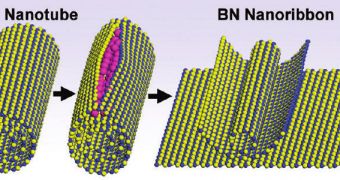A collaboration of investigators in the United States announces the development of a new method for producing defect-free boron nitride nanoribbons (BNNR) from boron nitride nanotubes (BNNT).
This approach leads to the creation of nearly-perfect BNNR, and all that is needed in order for that to happen is to insert atoms of potassium inside the nanoscale tubes. The pressure that builds up from within cracks the tubes over a longitudinal seam.
Experts with the group say that the BNNR that form as a result are of uniform lengths and thicknesses, and also defect-free. These nanoscale structures are produced because they hold great promise of displaying advanced magnetic and electronic properties.
Future electronic devices could exceed known performance levels several times over, thanks to studies being conducted today on materials such as boron nitride and graphene. The latter is a 2D carbon compound that is the strongest material in the world.
The new study was carried out by experts at the US Department of Energy (DOE) Lawrence Berkeley National Laboratory (Berkeley Lab), the University of California in Berkeley (UCB), and scientists at the Rice University.
“There has been a significant amount of theoretical work indicating that, depending on the ribbon edges, boron nitride nanoribbons may exhibit ferromagnetism or anti-ferromagnetism, as well as spin-polarized transport which is either metallic or semi-conducting,” expert Alex Zettl says.
The physicist is a globally-renowned nanoscale systems researcher, and is based at the Berkeley lab MSD, and the UCB Physics Department. He is also the director of the Center of Integrated Nanomechanical Systems (COINS) at UCB.
“The unique properties of boron nitride nanoribbons are of great fundamental scientific interest and also have implications for applications in technologies that include spintronics and optoelectronics,” the investigator goes on to say.
“However, the facile, scalable synthesis of high quality boron nitride nanoribbons has been a significant challenge,” he adds. Physicists believe that combining the properties of boron nitride and graphene could result in materials unlike anything we've ever produced before.
Zettl adds that the potassium-based splitting system is actually quite simple and ingenious. “The likely mechanism for the splitting of both carbon and boron nitride nanotubes is that potassium islands grow from an initial starting point of intercalation,” he explains.
“This island growth continues until enough circumferential strain results in a breakage of the chemical bonds of the intercalated nanotube. The potassium then begins bonding to the bare ribbon edge, inducing further splitting,” the expert concludes.
Details of the new study were published in a paper entitled “Longitudinal Splitting of Boron Nitride Nanotubes for the Facile Synthesis of High Quality Boron Nitride Nanoribbons,” that appears in the latest issue of the esteemed journal Nano Letters
Funds for this investigation were provided by the DOE Office of Science, the US National Science Foundation (NSF) Center of Integrated Nanomechanical Systems (COINS), the Office of Naval Research, and the Air Force Research Laboratory.

 14 DAY TRIAL //
14 DAY TRIAL //